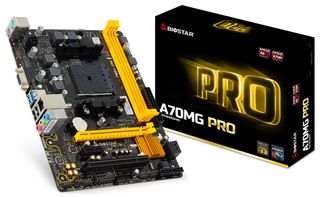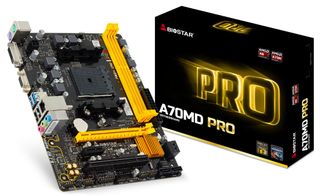Biostar Introduces Trio Of AMD A70M Motherboards

Biostar revealed a set of new motherboards that it will soon be releasing. The company’s Pro series AMD motherboards have been designed to be affordable options for AMD APU-based PCs.
Biostar’s A70MD PRO, A70MG PRO and A68MD PRO motherboards all feature AMD’s A70M chipset, which supports AMD A4, A6, A8 and A10 APUs, as well as AMD E2 and Athlon X4 processors. Each board includes two DIMM slots that support DDR3-2600, four Sata III ports for storage, and a gigabit NIC.

All three of the new Pro series boards are built on the mATX form factor, and they all feature the same expansion options: one PCIe 3.0 x16, a single PCIe 2.0 x1, and a legacy PCI slot. The boards also feature 10 USB ports each -- four USB 3.0 and six USB 2.0 ports -- but only two of each are mounted to the board. The rest can be accessed through headers on the board.

The three boards don’t appear to be very different. On paper, it appears they share most of the same features. They all include Nichicon audio capacitors, Iron Heart Protect reinforced metal backplates, and feature Tough Power Enhanced power design meant for high current resistance. The only real difference is with the A70MG PRO, which doesn’t include a DVI interface and lacks the 100% solid capacitors found on the other two models.
| Model | A70MD PRO | A70MG PRO | A68MD PRO |
|---|---|---|---|
| CPU | AMD FM2/FM2+ Processor | AMD FM2/FM2+ Processor | AMD FM2/FM2+ Processor |
| Power | 5phase | 5phase | 5phase |
| Chipsets | A70M | A70M | A70M |
| Solid cap | 100% | CPU in/output | 100% |
| Memory | 2 x DDR3-2600(OC) | 2 x DDR3-2600(OC) | 2 x DDR3-2600(OC) |
| Expansion Slot | 1 x PCI-E 3.0 x16 | 1 x PCI-E 3.0 x16 | 1 x PCI-E 3.0 x16 |
| 1 x PCI-E 2.0 x1 | 1 x PCI-E 2.0 x1 | 1 x PCI-E 2.0 x1 | |
| 1 x PCI | 1 x PCI | 1 x PCI | |
| LAN | GbE (RTL8111G) | GbE (RTL8111G) | GbE (RTL8111G) |
| Storage | 4SATA3 | 4SATA3 | 4SATA3 |
| Video | VGA , DVI | VGA | VGA , DVI |
| USB 3.0 / 2.0 | 4USB 3.0(2+2) / 6USB 2.0 (4+2) | 4USB 3.0(2+2) / 6USB 2.0 (4+2) | 4USB 3.0(2+2) / 6USB 2.0 (4+2) |
| Feature | Watch Dog, BIO-Relife, BIO-Flasher, BIOSTAR Flash, e-HotLine, BIO-Watch, Smart Speed LAN, BIOS Screen | Watch Dog, BIO-Relife, BIO-Flasher, BIOSTAR Flash, e-HotLine, BIO-Watch, Smart Speed LAN, BIOS Screen | Watch Dog, BIO-Relife, BIO-Flasher, BIOSTAR Flash, e-HotLine, BIO-Watch, Smart Speed LAN, BIOS Screen |
Biostar did not release the prices of the Pro series motherboards, but the company was adamant about these products being a great value proposition. We’ve asked Biostar for more details, but we expect these boards to be very competitively priced. The boards will go on sale at Biostar’s eBay store in the near future.
Update, January 27, 11:15am PT: The CPU support has been updated. Athlon II X4 is not supported, Athlon X4 is.
Follow Kevin Carbotte @pumcypuhoy. Follow us on Facebook, Google+, RSS, Twitter and YouTube
Stay on the Cutting Edge
Join the experts who read Tom's Hardware for the inside track on enthusiast PC tech news — and have for over 25 years. We'll send breaking news and in-depth reviews of CPUs, GPUs, AI, maker hardware and more straight to your inbox.
Kevin Carbotte is a contributing writer for Tom's Hardware who primarily covers VR and AR hardware. He has been writing for us for more than four years.
-
Onus There seem to be very few Biostar boards left at Newegg now. On the one hand, that's kind of a shame, because at least one of their boards I reviewed recently was a notable step up from what one might expect. On the other hand, others among their current offerings are notably unpolished.Reply
-
epobirs Seems like a mistake here. Two of the boards appear exactly the same but one of them has a name guaranteed to cause it to be mistaken for a different chip set.Reply -
alextheblue I'm not sure I'd bother releasing new AMD boards until AM4 arrives. It's my understanding that the AM4 platform is just around the corner, and will have current-gen chips available for it but you'll naturally be able to drop in Zen-based chips later.Reply
Of course in a budget system it may not matter. Only enthusiasts generally look for an upgrade path. I myself always like to have an upgrade path for at least one quick system overhaul on the cheap (CPU and GPU swap for example). -
Lutfij Budget builds actually take advantage of either lower costing current gen tech or mid-high end previous gen tech.Whichever way you look at it, its a good way to integrate someone on the fence about an upgrade for their HTPC or perhaps a very tight budget build to adopt such parts.Reply
I would like to keep one point in reserve, that the cost hasn't been mentioned and my comment can be tossed out the window :P -
bgunner {"Biostar’s A70MD PRO, A70MG PRO and A68MD PRO motherboards all feature AMD’s A70M chipset, which supports AMD A4, A6, A8 and A10 APUs, as well as AMD E2 and Athlon II X4 processors."}Reply
Please correct me if I'm wrong But last time I checked the Athlon II X4 CPU's are an AM3 socket CPU and not a FM2/FM2+ CPU?
Are you sure that this is not a typo that snuck in there? -
blppt Parents' P43/Q6600 Biostar combo still going strong after nearly 7 years. They may not be as overclocking friendly as ASUS/Gigabyte/MSI but build quality is apparently fine.Reply -
TechyInAZ Reply{"Biostar’s A70MD PRO, A70MG PRO and A68MD PRO motherboards all feature AMD’s A70M chipset, which supports AMD A4, A6, A8 and A10 APUs, as well as AMD E2 and Athlon II X4 processors."}
Please correct me if I'm wrong But last time I checked the Athlon II X4 CPU's are an AM3 socket CPU and not a FM2/FM2+ CPU?
Are you sure that this is not a typo that snuck in there?
Your correct. The correct term is "Athlon X4" -
alextheblue ReplyBudget builds actually take advantage of either lower costing current gen tech or mid-high end previous gen tech.Whichever way you look at it, its a good way to integrate someone on the fence about an upgrade for their HTPC or perhaps a very tight budget build to adopt such parts.
I would like to keep one point in reserve, that the cost hasn't been mentioned and my comment can be tossed out the window :P
But why release NEW boards? You already have tons of existing FM2+ boards spanning the entire range. Unless they figured out how to cut costs without cutting quality with a new design, or add features relevant to HTPC or similar.
Personally I think the conventional-sized HTPC market is shrinking as various kinds of HDMI sticks and consoles gain more capabilities. I mean look at some of the newer Intel sticks, roughly $150 and Cherry Trail? That would handle the majority of use cases, outside of enthusiasts. Even HEVC is possible if you're using playback software that taps into the HEVC hardware decoding block.
The last bastions for larger-chassis HTPCs are things like combo gaming/media systems (and streaming games is gaining traction) and audiophile/videophile domains. If you're like me and you want discrete audio and the most accurate video rendering, then it still makes sense. Otherwise what's onboard something like Cherry Trail is good enough for many users.
Most Popular



